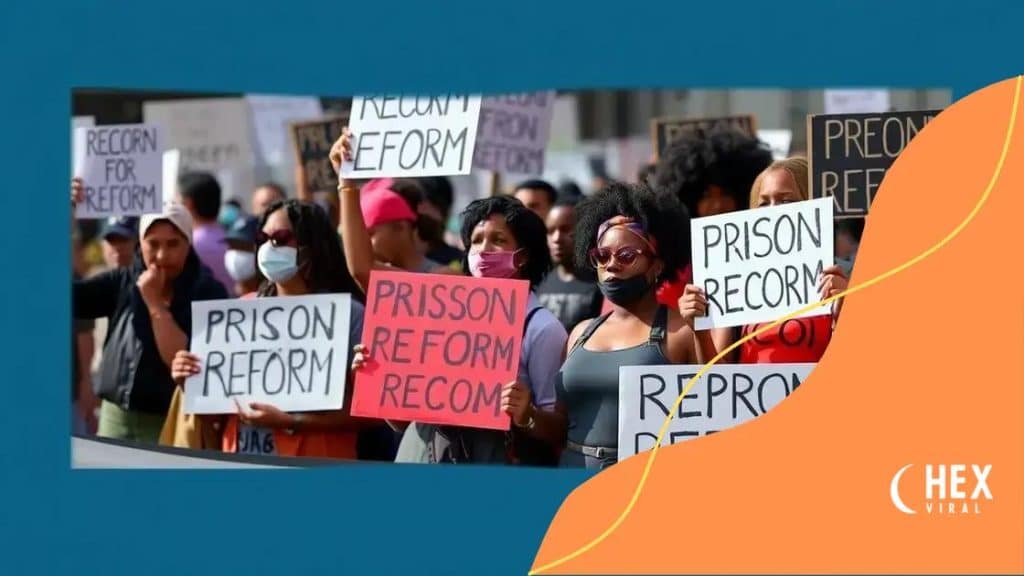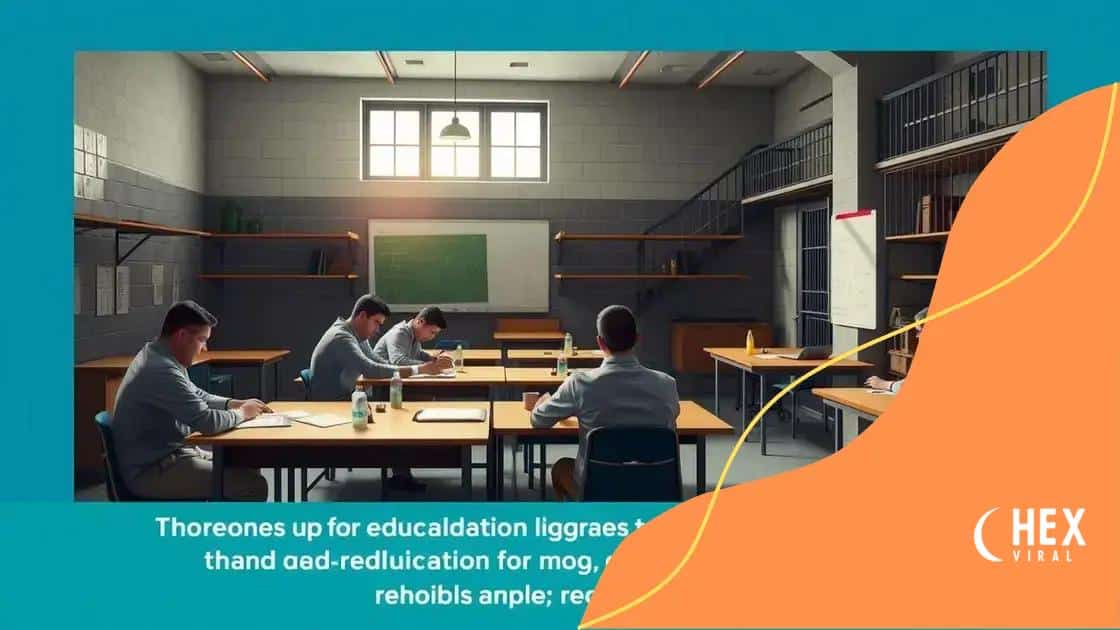Prison reform advocacy movements: pushing for change

Prison reform advocacy movements aim to transform the justice system by promoting rehabilitation over punishment, addressing issues like overcrowding, and enhancing support for mental health and educational programs for inmates.
Prison reform advocacy movements have gained momentum in recent years, pushing for significant changes in our justice system. Have you noticed how these initiatives aim to create a fairer and more humane approach to incarceration? Join me as we explore the driving forces behind this important cause.
Understanding prison reform advocacy
Understanding prison reform advocacy is crucial in today’s climate of social change. These movements aim to transform the justice system by addressing issues like overcrowding and harsh sentences.
What Is Prison Reform?
Prison reform refers to efforts aimed at improving the conditions and practices within correctional facilities. Advocates strive for more humane treatment of inmates and encourage policies that focus on rehabilitation rather than punishment.
Key Goals of Advocacy Movements
Advocacy movements focus on several important goals:
- Reducing prison populations through sentencing reforms.
- Improving healthcare and mental health services for inmates.
- Advocating for alternatives to incarceration, like community service.
- Ensuring fair treatment regardless of race or background.
Understanding these goals helps shed light on the larger picture of how prison reform advocacy seeks to create a more just system. It’s about more than just laws; it’s about creating a society that values rehabilitation and support.
Additionally, knowing the key players in these movements can enhance our understanding. Organizations and individuals work tirelessly to raise awareness and push for reform. They often collaborate with lawmakers and community leaders to foster positive changes.
Advocates use data and personal stories to illustrate the need for reform. By sharing experiences, they highlight the potential benefits of a reformed system. This way, they connect with the public and effectively argue for change.
Key players in prison reform movements
Key players in prison reform movements are essential for driving change within the justice system. They include a variety of individuals and organizations dedicated to creating a fairer, more effective system.
Advocacy Organizations
Many non-profit organizations are at the forefront of prison reform. These groups work diligently to raise awareness and influence policy. They provide resources, gather data, and connect with communities to help advocate for necessary changes.
- The Vera Institute of Justice focuses on creating solutions for a fair justice system.
- The American Civil Liberties Union (ACLU) fights for the rights of incarcerated individuals.
- Families Against Mandatory Minimums (FAMM) advocates for sentencing reforms.
- The Sentencing Project conducts research and reform initiatives on sentencing policies.
In addition to organizations, individual advocates also play a vital role. Activists often use their personal stories to highlight the injustices in the system. By sharing experiences, they can connect emotionally with the public and lawmakers alike.
Lawmakers and Politicians
Lawmakers are crucial in implementing changes through legislation. Some politicians champion prison reform initiatives, pushing for new policies that prioritize rehabilitation. Collaborations between advocates and politicians help create bipartisan support for reforms, making changes more attainable.
Community leaders also contribute significantly to these movements. They educate the public about the issues at hand, organize local events, and mobilize support for reforms. By fostering a sense of community, they strengthen the push for change.
The intersection of these players—advocates, organizations, lawmakers, and community members—creates a powerful coalition. Together, they work towards achieving a more just and equitable criminal justice system.
Success stories: Effective prison reform

Success stories in effective prison reform highlight how meaningful change can transform lives and communities. These examples showcase the potential for rehabilitation and a more humane approach to justice.
Notable Reform Initiatives
Different programs have achieved remarkable results. For instance, the focus on mental health treatment instead of punitive measures can reduce recidivism rates significantly.
- Skill-building programs help prepare inmates for jobs after release.
- Education initiatives within prisons improve literacy and offer new opportunities.
- Restorative justice programs promote healing between victims and offenders.
- Community service alternatives allow offenders to contribute positively to society.
These initiatives not only help individuals but also benefit society as a whole by reducing crime rates. Understanding these successes can inspire further changes across the justice system.
Real-Life Examples
One outstanding example is the program initiated in California, which reformed its parole process. This approach emphasized rehabilitation over punishment and led to a significant drop in re-offending.
Furthermore, the program in New York focusing on inmates’ education has shown that providing inmates with skills can drastically change their lives. Many former inmates have reported better job prospects and a lower chance of returning to prison.
Across the United States, different states are adopting similar programs, proving that change is possible. These successful stories highlight the importance of implementing reforms that focus on rehabilitation and support.
Challenges faced by reform advocates
Challenges faced by reform advocates in the prison system are numerous and often daunting. Navigating the complex landscape of criminal justice reform requires perseverance and strategic action.
Political Opposition
One major challenge is political opposition. Reform advocates often encounter resistance from lawmakers who may fear losing votes by supporting radical change. This can stall important measures that aim to improve the justice system.
Additionally, misinformation can fuel this resistance. Misunderstandings about the goals of reform, such as associating them solely with leniency, can create negative perceptions among the public and politicians.
Resource Limitations
Another significant hurdle is the lack of resources. Many advocacy groups function with limited funding, which can restrict their ability to conduct research, launch campaigns, or provide support to affected individuals.
- Funding is often needed for outreach programs.
- Research is critical for providing evidence that supports reform efforts.
- Advocacy campaigns require costs for materials and events.
- Legal assistance can help individuals navigate the justice system.
With insufficient resources, it becomes challenging for advocates to make their voices heard and demonstrate the need for reform effectively.
Public Perception
Changing public perception is another formidable challenge. Many people may view the prison system as entirely punitive. Advocates need to educate the public about the importance of rehabilitation and how it can lead to a safer society.
Overcoming stereotypes about those who are incarcerated is essential. Advocates work to humanize these individuals, showing that many can change given the right support. By focusing on success stories, they can help shift perceptions over time.
Despite these challenges, reform advocates remain committed to creating a fairer, more humane justice system. They understand that change takes time but believe in the power of their work.
The future of prison reform advocacy
The future of prison reform advocacy looks promising yet challenging. As awareness grows about the issues within the criminal justice system, more people are joining the movement for change. This growing involvement is paving the way for significant reforms.
Increased Public Awareness
Public awareness is expanding rapidly. More individuals are learning about the impact of prison reform on communities and families. This knowledge is driving conversations at dinner tables, schools, and workplaces.
Social media plays a vital role in spreading information. Advocates are using these platforms to share stories, statistics, and successes, which helps to engage a broader audience. This type of engagement can lead to increased pressure on lawmakers.
Legislative Changes
As public support grows, lawmakers are likely to feel compelled to address the calls for reform. New policies may emerge focusing on rehabilitation over punishment. Advocates are optimistic about initiatives aimed at improving education and job training for inmates.
- Expected reforms may include alternatives to incarceration for low-level offenses.
- Prison conditions may improve due to new regulations promoting humane treatment.
- Investments in mental health services within prisons could become standard.
- Community-led rehabilitation programs might receive more funding.
Another potential change involves collaboration between various stakeholders, including government agencies, non-profits, and former inmates. By including diverse voices in the conversation, solutions can be more comprehensive.
Moreover, technological advancements may offer new opportunities for tracking outcomes of reforms. Enhanced data collection can help demonstrate the effectiveness of various programs, showing lawmakers and the public that reform works.
Ultimately, the landscape of prison reform advocacy is evolving rapidly. With unity, informed voices, and strategic action, advocates can drive meaningful change in the criminal justice system.
FAQ – Frequently Asked Questions about Prison Reform Advocacy
What is prison reform advocacy?
Prison reform advocacy involves efforts to change the justice system to focus on rehabilitation instead of punishment, ensuring humane treatment for all inmates.
Why is public awareness important for prison reform?
Public awareness helps gather support for reform initiatives and pressures lawmakers to take action on important issues within the justice system.
What are some challenges faced by reform advocates?
Advocates often encounter challenges such as political opposition, resource limitations, and changing public perceptions about incarceration.
What does the future hold for prison reform advocacy?
The future looks promising with increasing public support, potential legislative changes, and a focus on education and mental health initiatives for inmates.






